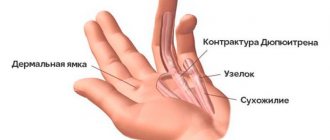This is a surgical intervention aimed at correcting, restoring or creating from scratch the male genital organ using the patient’s skin.
Surgeons at the URO-PRO clinic in Krasnodar have the latest equipment and successfully use both conservative and surgical techniques for therapeutic and aesthetic purposes. With us you will return the classic anatomy to the penis or improve it. The qualifications and experience of doctors at the URO-PRO clinic in Krasnodar allows procedures to be performed safely and with a minimum of short-term complications. At the same time, potency, urination, the ability to ejaculate and achieve orgasm are not impaired, and the rehabilitation period is reduced.
Indications and contraindications
Indications
for phalloplasty:
- organ failure;
- abnormal development (ectopia, hypospadias, etc.);
- injuries and damages;
- small size, thickness or underdevelopment;
- deformation, for example, with Peyronie's disease;
- diseases requiring tissue removal;
- gangrene;
- artificial sex change.
Contraindications:
- serious pathological problems in the body;
- uncompensated diabetes mellitus;
- inflammation of the genitourinary organs;
- mental, autoimmune, sexually transmitted diseases;
- poor blood clotting.
The most common operation now is to increase the size of the penis. Genital surgery can offer many solutions to this issue.
The main material used for phalloplasty at Dr. Kamol's clinic is a free fibula flap. We have made great strides in this area. Dr. Kamol leads a team of highly specialized surgeons in micro cosmetic surgery.
Goals of phalloplasty:
- Creation of a sensitive and aesthetically acceptable penis of sufficient length and size for full sex with the possibility of penetration (possible thanks to a special erectile prosthesis) - Lengthening the urethra to the tip of the penis, to allow urination in a standing position (like a genetic man) - Providing orgasmic abilities (the ability to have an orgasm) - Minimum number and size of postoperative sutures, minimal functional loss and maximum protection of the donor area
The last stage involves the creation of male reproductive organs. When the patient has reached this stage, the external physical features of the patient are almost the same as those of men, flat chest, no uterus, while in a standing position, but without the male organ, the patient cannot control the direction and flow of urine.
I. ALT + Mini radial forearm flaps (thigh and forearm)
ALT (Anterolateral Thigh Flap) is the latest technique with increasing acceptance among specialists for performing phalloplasty. This technique makes it possible to eliminate the disadvantage of a large donor scar from a radial forearm flap. The ALT flap neophallus is larger and softer, which is more suitable for a penile implant than the radial forearm flap.
The procedure involves using skin and nerves from the upper outer thigh and transplanting it into the genital area to create a neophallus.
Advantages
- Small, linear scar on the forearm - Donor scar on the upper thigh is not noticeable - Creation of a new urethra and penis can be done in one step. — The new phallus is larger and of appropriate size. - More stable as a penile implant - No bone loss
Flaws
— The need for penile implantation
Execution technique
Step 1: Total hysterectomy + uterus removal, vaginal closure and urethral lengthening Step 2: Microsurgical creation of the penis and urethra Step 3: Penile and testicular implantation
Rice. 1: Donor flap for ALT phalloplasty
Rice. 2: The new phallus is installed in its natural position
II. Technique for using the skin of the radius of the forearm
The procedure involves the use of skin from the inside of the forearm (donor zone), which contains nerves for the urethra and blood vessels. The neophallus is created using microsurgical techniques. At this stage, the neophallus does not have penile rigidity and the next step is implantation.
Advantages
— The simplest method of microsurgery — Slight narrowing of the urethral canal
Flaws
- Large forearm scar
— Subsequent surgery for penile implantation (penile implantation)
— Small size and flabby shape
- Less resistance to penile implants
Technique
Step 1: Total hysterectomy + hysterectomy, vaginal closure and urethral lengthening
Step 2: Creation of a new penis and urethra using microsurgical method
Step 3: Penile and Testicular Implantation
Rice. 3 : Donor site of the radius of the forearm phalloplasty
Rice. 4: The donor surface is covered with a skin flap
The urethra is connected during phalloplasty or 6 months after surgery to reduce urine leakage.
III. Fibula
The procedure involves using skin, part of the fibula, nerves, urethra and blood vessels from a non-visible part of the leg to create a neophallus using microsurgery techniques.
Advantage
- Penis rigidity from the fibula - Appropriate size and softer tissue - The scar on the leg is less noticeable than on the forearm
Flaws
— It will take 6-8 weeks for the leg to recover — The need for dilation of the urethra in 1-2 years
Technique of the operation
Step 1: Making urethra from leg skin using buttock or groin skin, total hysterectomy, ovary removal, urethra, vagina lengthening
Step 2: Creation of a new penis (neophallus) using microsurgery technique
Step 3: Connect the urethra and design the glans
The time period for each step is approximately 6-8 months.
Rice. 5 : Pre-lamination of the urethra on the lower leg for 6 months
Rice. 6: Donor skin flap from the fibula area
Rice. 7: The middle part of the fibula is cut out to make a neophallus.
Plastic surgery on the scrotum
The scrotum provides not only aesthetic satisfaction for the patient, but also makes life in the male role easier, most noticeably when a man appears in underwear. Our surgeons' experience in performing plastic surgery on the scrotum allows us to perform such operations using tissue from the labia majora to create a neo-scrotum that is correctly positioned over the former openings.
Risks and complications of phalloplasty
Possible major risks: swelling, bruising, bleeding, infection, scarring, numbness or changes in sensation. Please follow the surgeon's advice to reduce risks and complications.
Penis enlargement
Currently, the following methods are popular among patients and doctors:
- Conservative
An extender is a special device that is fixed to an organ for stretching for several hours a day. The cells themselves divide under the stress of stretching. It is small in size and hides under clothing.
- Operational
Ligamentotomy - the ligament that supports the penis is cut, the hidden part is released. It is often used in combination with the first, which allows an average lengthening of five centimeters to be achieved.
- Microsurgery
Skin-fat tissues are transferred, for example, from the buttock or a nearby muscle area.
- Vacuum
The most long-term solution, the vacuum system is used for a year, an increase of three centimeters.
- Biomatrix
Injected into connective tissue. At the same time, natural tissues are not deformed, the effect is lifelong.
You select the appropriate solution together with a highly qualified andrologist in accordance with your clinical chart. Please note that such decisions are made only after consultation with specialists. Protect yourself from dubious and sometimes dangerous offers!
CONTENT
- 1. History
- 2 Indications
- 3 Methods and associated procedures
- 4 penile implants
- 5 Technique explained 5.1 Freehand flap
- 5.2 Lateral breast flap
- 5.3 Leg flap
- 5.4 Pubic flap
- 5.5 Gillis technique
- 5.6 Abdominal muscle
- 5.7 Subcutaneous soft silicone implant
- 5.8 Non-contact surgical technique 5.8.1 Procedure
Preparing for surgery
It is impossible to say exactly how much time is needed for collecting anamnesis, the preparatory period, the operation itself and rehabilitation. The problems that need to be solved vary greatly from person to person. But it is always necessary to undergo a clinical examination. If you have the following tests ready, the preoperative period will be reduced:
- general blood and urine examination,
- blood biochemistry,
- coagulogram,
- ECG,
- fluorography,
- testing for infections (HIV, hepatitis, syphilis),
- smear for urethrogenital infections.
An appointment with an anesthesiologist is often necessary. Reducing the load on the body can be achieved by giving up alcohol, smoking and taking medications at least five days before the expected procedure. In the evening before the actual intervention, you need to shave the groin hair and wash thoroughly. Eating is strictly prohibited.
Links[edit]
- Rashid M, Tamimy MS (2013). "Phalloplasty: dream and reality". Indian J Plast Surg
.
46
(2):283–93. DOI: 10.4103/0970-0358.118606. PMC 3901910. PMID 24501465. - Segal RL, Camper SB, Burnett AL (2014). "Current Use of Penile Prosthesis Surgery: Analysis of a National Claims Registry". Int J Impot Res
.
26
(5): 167–71. DOI: 10.1038/ijir.2014.11. PMID 24830674. S2CID 205152894. - Schultheiss D, Gabouev A.I., Jonas U (2005). "Nicholas A. Bogoraz (1874-1952): Pioneer of Phalloplasty and Penile Implant Surgery." J Sex Med
.
2
(1): 139–46. DOI: 10.1111/j.1743-6109.2005.20114.x. PMID 16422917. - Morrison, Shane D.; Shakir, Afaf; Vyas, Krishna S.; Kirby, Joanna; Crane, Curtis N.; Lee, Gordon K. (September 2016). "Phalloplasty: a review of methods and results." Plastic and reconstructive surgery
.
138
(3):594–615. DOI: 10.1097/PRS.0000000000002518. ISSN 0032-1052. PMID 27556603. S2CID 40941956. - "American Urological Association - Penile Enlargement Surgery". www.auanet.org
. Retrieved March 14, 2022. - "Bioengineered Bodily Tissue for Structural and Functional Penile Repair" Kuo-Liang Chen, Daniel Eberly, James J. Yu, and Anthony Atala (Proceedings of the National Academy of Sciences, Vol. 106, No. 45, November 9, 2009)
- Carrion, Hernan; Martinez, Daniel; Parker, Justin; Hakki, Tariq; Bickell, Michael; Boyle, Alexander; Weigand, Luke; Carrion, Rafael (July 2016). "The History of the Penile Implant to 1974." Sexual Medicine Reviews
.
4
(3):285–293. DOI: 10.1016/j.sxmr.2016.05.003. PMID 27871961. - Kang, Audrey; Aizen, Joshua M.; Cohen, Andrew J.; Bales, Gregory T.; Pariser, Joseph J. (June 2022). "Methods and features of surgical prosthetics after phalloplasty in transgender men". Translational andrology and urology
.
8
(3): 273–282. DOI: 10.21037/tau.2019.06.02. PMC 6626310. PMID 31380234. - ↑
Chang, Eric (February 2022).
"Penile Prosthesis Implant: Scientific Advances and Technological Innovations over the Past Four Decades". Translational andrology and urology
.
6
(1): 37–45. DOI: 10.21037/tau.2016.12.06. PMC 5313299. PMID 28217449. - van der Sluis, Wouter B.; Pigot, Harry L.S.; Al-Tamimi, Muhammad; Ronkes, Brechje L.; de Haseth, Kristin B.; Ozer, Muide; Smith, Jan Marten; Buncamper, Marlon E.; Bowman, Mark-Bram (October 2019). "A retrospective cohort study of surgical outcomes of penile prosthesis implantation in transgender men after phalloplasty." Urology
.
132
: 195–201. DOI: 10.1016/j.urology.2019.06.010. - Pigot, Harry LS; Sigurjonsson, Hannes; Ronkes, Breche; Al-Tamimi, Muhammad; van der Sluis, Wouter B. (January 2022). "Surgical experience and results of implantation of the ZSI 100 FtM flexible penile implant in transgender men after phalloplasty." Journal of Sexual Medicine
.
17
(1): 152–158. DOI: 10.1016/j.jsxm.2019.09.019. - Shirvanyan, V.; Lemperle, G.; Araujo Pinto, C.; Elist, J. J. (2014). "Implantation of a shortened penis after implantation of a penile prosthesis treated with a subcutaneous soft silicone penile implant: a case report." International Journal of Impotence Research
.
26
(3): 100–104. DOI: 10.1038/ijir.2013.44. PMID 24305609. S2CID 25075692. - "Shortened penile prosthesis after the penis". MDLinx. Retrieved February 16 +2016.
- "A retrospective evaluation of the safety and effectiveness of a silicone locking implant for elective penile cosmetic surgery". SMSNA.org. Archived from the original on 2016-03-01. Retrieved February 18, 2016.
- ↑
Hannah Smothers (January 27, 2016).
"Penile implants exist now, and they start big". Cosmopolitan.com
. - ^ ab Eade, J. Francois (2011). "Technique without touching" J Sex Med
.
8
(1): 5–8. DOI: 10.1111/j.1743-6109.2010.02137.x. PMID 21199375. - Mulcahy, John J. (2010). "Current approach to the treatment of penile implant infections". Therapeutic Advances in Urology
.
2
(2): 69–75. DOI: 10.1177/1756287210370330. PMC 3126071. PMID 21789084. - Gomelsky, A.; Dmochowski, R.R. (2003). "Antibiotic prophylaxis in urological prosthetic surgery." Current Pharmaceutical Design
.
9
(12): 989–96. DOI: 10.2174/1381612033455198. PMID 12678865. - ^ a b Eade, J. Francois; Wilson, Stephen K.; Cleves, Mario; Salem, Emad A. (2012). "Coated implants and 'no-touch' surgical techniques reduce the risk of infection during implantation of inflatable penile prostheses by 0.46%." Urology
.
79
(6):1310–5. DOI: 10.1016/j.urology.2011.11.076. PMID 22521187. - Jump up
↑ Carson, C. C. (2004).
"Effectiveness of Antibiotic Impregnation of Inflatable Penile Prostheses in Reducing Infection of Original Implants." J Urol
.
171
(4):1611–4. DOI: 10.1097/01.ju.0000118245.66976.e1. PMID 15017233. - Elmussareh, Muhammad; Goddard, Jonathan Charles; Summerton, Duncan John; Terry, Timothy Robin (2013). "Minimizing the risk of device infection in penile prosthetics: a UK perspective." Journal of Clinical Urology
.
6
(5): 280–288. DOI: 10.1177/2051415813488367. S2CID 57282051. - Münch, Peter J. (2013). "Infections against penile implants: the war against bugs." Journal of Urology
.
189
(5):1631–1673. DOI: 10.1016/j.juro.2012.05.080. PMID 23085299. - Richard Piercy and Raj Persad, publication date unknown, “Inflatable Penile Prosthesis,” in BJU International Website Atlas of Surgery and Surgical Devices, see [1], accessed May 31, 2014.
- Chen KL, Eberly D, Yoo JJ, Atala A (November 2009). "Regenerative Medicine Feature: Bioengineered Bodily Tissue for Structural and Functional Penile Restoration". Proceedings of the National Academy of Sciences of the United States of America
.
107
(8):3346–50. DOI: 10.1073/pnas.0909367106. PMC 2840474. PMID 19915140. - Zilg, Brita; Rasten-Almqvist, Petra (2017). "Fatal Fat Embolism Following Penile Enlargement by Autotransfer Fat Transfer: A Case Report and Review of the Literature." Journal of Forensic Medicine
.
62
(5):1383–1385. DOI: 10.1111/1556-4029.13403. PMID 28749069. S2CID 4775170.
Consequences of phalloplasty
Plastic surgery helps patients improve the quality of their sex life and cope with psychological and social problems. But complex surgical interventions can also have negative effects:
- deterioration of erectile function or complete impotence;
- decreased or complete absence of sensitivity;
- difficulty and pain when urinating;
- complications after surgery, infection, inflammation;
- rejection of implants and the patient’s own tissues.
Therefore, before agreeing to phalloplasty, you should weigh everything, give yourself a few months to think, and study the information. If possible, try non-surgical penis enlargement methods that will give results without risks. In resolving such a delicate issue, it is better not to save money and choose specialists who, in case of complications, will be able to provide any assistance.
Article reviewer
Petrovich Ruslan Yurievich
Urologist-andrologist, microsurgeon, plastic surgeon. Specialization: surgical andrology, plastic surgery. 20 years of experience. Doctor's contacts
Ask a Question
Recommended by topic
Rating of extenders The main difference between extenders is the glans clamp - the unit through which the stretcher simulator transfers the load to the penis. Convenience depends on the design...
Read more
PeniMaster Pro in postoperative traction Study-review on the choice of options for postoperative traction during ligamentotomy Authors: Yu. A. Kravtsov, Associate Professor of the Institute of Surgery, TSMU;
Yu. P. Pakholyuk;… Read more
Phalloplasty: before and after changes, sensitivity
Before and after phalloplasty, the changes are dramatic - the penis acquires normal size/shape, its sensitivity most often remains at the same level, but often decreases slightly. In the latter case, a man should simply consult with a psychologist and sex therapist - perhaps a partial decrease in the sensitivity of the penis will lead to an increase in the duration of sexual intercourse.
The most dramatic changes after phalloplasty occur when changing from female to male - you need, at a minimum, to get used to the new organ. Often the patient needs the help of psychotherapists and even psychiatrists.
Phalloplasty options
Since the indications for surgery are very different, unique proprietary surgical techniques are often used for patients. But phalloplasty is widely practiced in two ways - thoracodoxal or radial flap.
Thoracodorsal flap
To form a neophallus, a flap of skin is taken in the area of the latissimus dorsi muscle on the left side (thoracodorsal region). The flap includes the vascular pedicle and thoracodorsal motor nerve to provide blood supply and sensation to the newly created organ.
The surface from which the skin is removed is immediately covered with rotational plastic - the patient's skin located just below the donor area.
The skin flap is rolled into a tube and stitched. The size of the flap can be 11x18 to 14x22 cm. Fixation of the created neophallus takes place in several stages:
- attachment of muscle tissue to the pubic periosteum;
- the artery and vein of the flap are connected to the epigastric artery and vein; The thoracodorsal nerve connects to the motor nerve of the thigh.
After engraftment of the organ, the formation of the urethra, glans and prosthetics of the spongy bodies of the penis can be carried out.
In the case of micropenia, micropenis tissue is used to form the glans, and in gender reassignment surgery, the clitoris is used.
Radial flap
Two flaps of skin are taken from the forearm area. The fasciocutaneous flap is removed along with the feeding vessels. The penis is formed from two flaps, and the place where they join will become the urethra, which will later be connected to the urethra.
The difference between this method, called “phallourethroplasty,” and the previous one is that the neophallus and neourethra are formed simultaneously. With fallourethroplasty, the number of stages of surgery is reduced, and it is preferable for patients.
- Veins and arteries connect to the vessels of the lower epigastric zone.
- The radial nerve connects to the dorsal nerve of the penis.
- The donor site is covered with skin from the anterior outer surface of the thigh.
Phallourethroplasty has a good aesthetic result; urination can be performed while standing. The appearance of erogenous sensitivity of the organ is possible, and this is very important for sexual and social rehabilitation.
Stages of phalloplasty
Surgery is usually performed in several stages:
- A skin flap containing blood vessels, nerves and muscle tissue is taken from the patient.
- The surgical site is prepared in the groin area.
- The neophallus is fixed to the periosteum of the pubic bone, as well as suturing of blood, nerve and musculocutaneous tissues.
As time passes and the neophallus heals, approximately six months after surgery, additional surgical improvements may be performed:
- formation of the urethral canal – urethroplasty,
- implantation of a prosthetic corpus spongiosum of the penis to simulate an erection,
- formation of the head of the penis.
Upon completion of all these procedures, the penis should become aesthetically and functionally complete.










